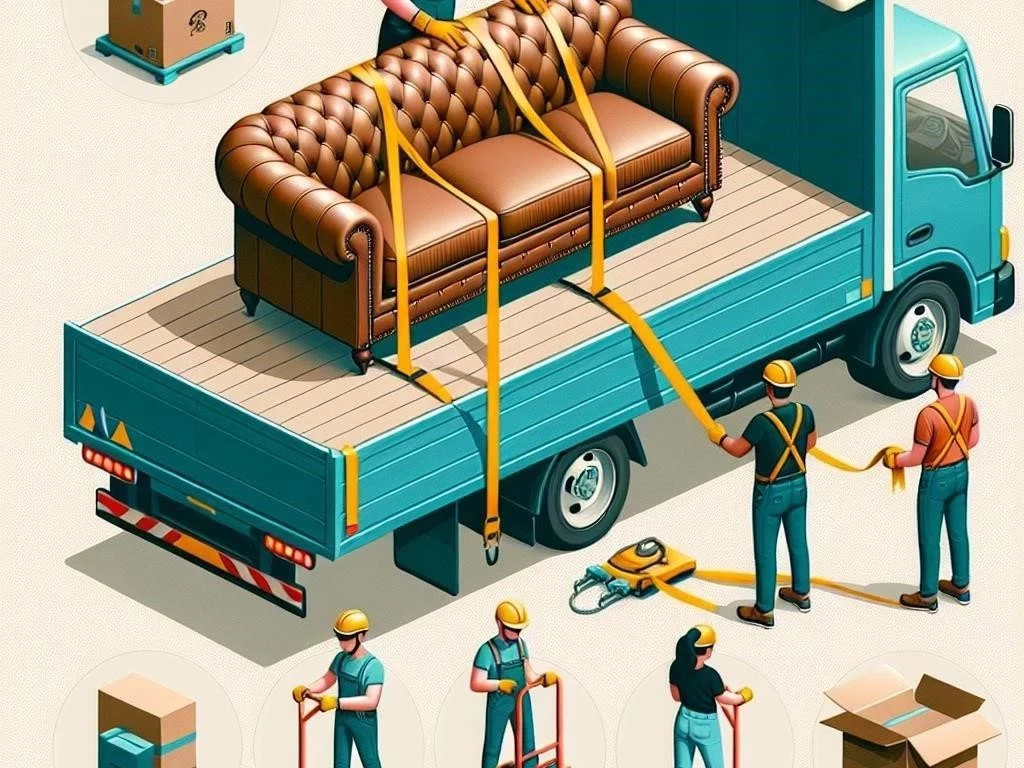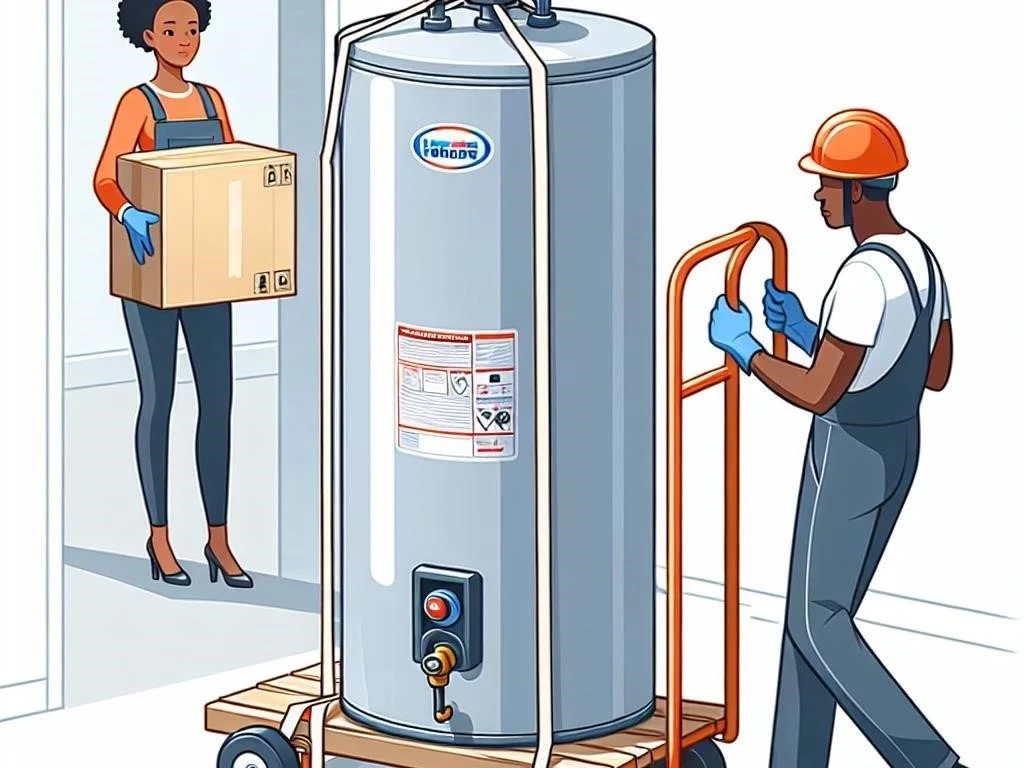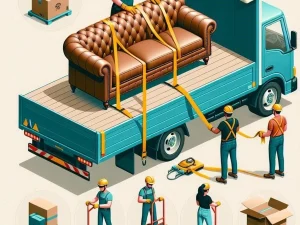How to Transport a Couch: A Comprehensive Guide
Transporting a couch requires careful consideration of logistics‚ packing‚ and unloading techniques to ensure safety‚ protection‚ and proper handling throughout the entire process.
Understanding the Importance of Proper Couch Transport
Proper couch transport minimizes risks of damage‚ ensures safety during relocation‚ and enhances efficiency‚ making the experience seamless for everyone involved in the process.
1.1 The Risks of Improper Handling
Improper handling during couch transport can lead to significant risks‚ including damage to the furniture‚ injury to movers‚ and potential harm to your home. Without adequate protection‚ a couch can sustain scratches‚ tears‚ or even structural damage. Moreover‚ lifting heavy furniture without the right tools increases the likelihood of accidents‚ causing strain or injury. Incorrect maneuvering through doorways and hallways may lead to further damage or even blockages. Ensuring proper techniques for carrying‚ loading‚ and unloading is essential to mitigate these risks‚ ultimately preserving both the couch’s integrity and the safety of everyone involved in the relocation process.
1.2 Benefits of Professional Movers
Hiring professional movers for couch transport offers numerous advantages‚ including expertise in handling heavy furniture and specialized equipment for safe relocation. These experts have experience in maneuvering through tight spaces‚ ensuring minimal risk of damage to both the couch and your home. Professional movers also provide essential tools like dollies‚ straps‚ and protective wrapping‚ enhancing safety during transport. Their logistics knowledge allows for efficient loading and unloading‚ saving you time and effort. Ultimately‚ enlisting professionals not only guarantees the couch’s preservation but also alleviates the stress associated with moving and managing the entire relocation process effectively.
Preparing for the Move
Preparing for couch transport involves assessing dimensions‚ measuring doorways‚ gathering necessary tools‚ and creating a strategic packing plan to ensure a smooth relocation process.
2.1 Assessing the Couch Dimensions
Before transporting your couch‚ accurately measuring its dimensions is crucial for successful relocation. Start by measuring the length‚ width‚ and height of the couch‚ considering any additional features like armrests or reclining mechanisms. This information helps determine the best approach for moving and if disassembly is necessary. Additionally‚ assess the weight‚ as it influences the choice of tools and assistance required for handling. Understanding the couch’s dimensions also aids in determining the appropriate transport vehicle‚ ensuring it fits comfortably without risking damage during transit. Proper assessment sets the foundation for a smooth and efficient moving experience.
2.2 Measuring Doorways and Hallways
Measuring doorways and hallways is essential for successful couch transport. Begin by measuring the width and height of door frames to ensure the couch can pass through without obstruction. Take note of any obstacles like light fixtures or furniture that may hinder movement. Additionally‚ measure hallways to confirm they provide enough space for maneuvering the couch‚ especially if it’s a large piece. If tight turns or narrow areas exist‚ consider disassembly options to facilitate easier transport. Accurate measurements help avoid unexpected challenges‚ ensuring a smooth transition from one space to another during the relocation process.
2.3 Gathering Necessary Tools
Before transporting your couch‚ gathering the right tools is crucial for a successful move. Essential tools include a dolly for easy maneuvering‚ straps for securing the couch during transport‚ and furniture blankets for protection against scratches and damage. Additionally‚ packing tape and bubble wrap can help safeguard delicate areas. Having tools like wrenches or screwdrivers on hand may be necessary for disassembly. Ensure you have adequate assistance‚ as well‚ to safely handle the weight. Preparing these tools in advance streamlines the moving process and enhances safety‚ ultimately ensuring a smooth couch relocation experience.
2.4 Creating a Packing Strategy
Developing a packing strategy is vital for efficient couch transport. Begin by determining the order of disassembly‚ if necessary‚ to facilitate easier handling. Use furniture blankets to wrap the couch securely‚ protecting it from scratches and damage during transit. Secure the wrapped couch with straps or packing tape to prevent movement. Plan the loading process‚ ensuring the couch is positioned safely within the transport vehicle‚ considering weight distribution for stability. Additionally‚ designate a specific unloading area at the destination to streamline the process. A well-thought-out packing strategy enhances safety and efficiency throughout the entire relocation journey.
Packing Your Couch for Transport
Packing your couch properly is essential for protection during transit‚ requiring careful selection of materials‚ wrapping techniques‚ and strategies to ensure safety and prevent damage.
3.1 Choosing the Right Protection
Selecting the appropriate protection for your couch during transport is crucial to prevent damage. Start with high-quality furniture blankets‚ which provide cushioning and safeguard against scratches. Additionally‚ consider using bubble wrap for delicate areas‚ such as wooden legs or armrests‚ to absorb shocks. For extra protection‚ corner guards can shield vulnerable edges. Ensure the wrapping is secured with packing tape or straps to prevent slippage during transport. If possible‚ use plastic wrap to cover fabric surfaces‚ protecting against dirt and moisture. Choosing the right protective materials significantly enhances the chances of maintaining your couch’s integrity throughout the move.
3.2 Wrapping Techniques for Safety
Utilizing effective wrapping techniques is vital for ensuring couch safety during transport. Begin by laying the couch flat on a clean surface‚ then cover it with a furniture blanket‚ ensuring it completely envelops the piece. Secure the blanket using packing tape or straps‚ making sure it adheres tightly to prevent movement. For added protection‚ wrap delicate areas‚ such as armrests and legs‚ with bubble wrap before covering them with the blanket. When using plastic wrap‚ apply it over the entire couch‚ focusing on seams and corners. Proper wrapping techniques significantly reduce the risk of damage during the relocation process.
3.3 Disassembly of Couch Components
Disassembling couch components can simplify transport and enhance safety. Begin by identifying removable parts such as cushions‚ legs‚ or sectional pieces. Use appropriate tools‚ like wrenches or screwdrivers‚ to carefully detach these components‚ ensuring you follow manufacturer guidelines to avoid damage. Label each piece for easy reassembly‚ using tape or a notepad to record where each component belongs. Store smaller parts in a designated bag to prevent loss during the move. Remember to wrap disassembled parts separately for protection. Proper disassembly not only facilitates easier handling but also minimizes the risk of damage throughout the transport process.
Loading the Couch onto the Truck
Loading the couch onto the truck requires careful handling‚ utilizing tools like dollies and straps to ensure safety and prevent damage during the entire process;
4.1 Using a Dolly for Easy Maneuvering
Using a dolly can significantly simplify the process of maneuvering a couch during transport. Start by positioning the dolly close to the couch‚ ensuring it’s stable. Carefully tilt the couch onto its side‚ allowing the dolly to slide beneath it. Secure the couch to the dolly with straps to prevent slipping during movement. Once secured‚ tilt the dolly back‚ using your legs to lift rather than your back to avoid injury. Navigate through doorways and hallways with caution‚ making sure to account for any tight spaces. A dolly enhances efficiency and safety‚ making the loading process manageable.
4.2 Proper Strapping Techniques
Implementing proper strapping techniques is essential for securing your couch during transport. Begin by positioning the couch inside the truck‚ ensuring it’s stable and upright. Utilize heavy-duty straps designed for moving‚ threading them through the couch’s frame or around its body. Tighten the straps to hold the couch firmly in place without causing damage to the fabric or structure. Ensure the straps are evenly distributed to prevent tipping during transit. Additionally‚ check the tension of the straps periodically throughout the journey‚ adjusting as necessary. Properly securing your couch minimizes movement‚ protecting it from potential damage while transporting.
4.3 Safety Tips during Loading
Prioritizing safety during the loading of your couch is crucial to prevent injuries and damage. Always wear appropriate footwear to enhance grip and stability while handling heavy furniture. Use lifting techniques that involve bending your knees and keeping your back straight to avoid strain. Communicate clearly with your team members to ensure everyone is aware of their roles during the loading process. Before moving the couch‚ clear the path of any obstacles that might cause tripping. Finally‚ take your time and don’t rush‚ as careful handling reduces the risk of accidents and ensures a smooth loading experience.
Transporting the Couch Over Distance
Transporting a couch over distance involves careful planning‚ ensuring secure placement‚ and considering factors like weight distribution and road conditions for a smooth journey.
5.1 Logistics of Couch Delivery
Understanding the logistics of couch delivery is essential for a successful transport experience. Start by planning the route‚ considering factors such as distance‚ traffic patterns‚ and road conditions. Ensure the transport vehicle is appropriate for the couch’s size and weight‚ providing ample space for secure placement. Schedule delivery times‚ coordinating with recipients to ensure availability upon arrival. Additionally‚ prepare for any potential obstacles‚ such as narrow streets or limited parking spaces‚ that may hinder access. Communicating with your team and employing effective strategies ensures a smooth delivery process‚ minimizing delays and complications during couch transport.
5.2 Managing Weight and Space in the Truck
Effectively managing weight and space in the truck is crucial for safe couch transport. Begin by calculating the couch’s weight and considering the truck’s weight capacity to prevent overload. Position the couch strategically‚ ensuring it rests against the truck’s walls for maximum stability. Distribute the weight evenly across the vehicle floor to avoid shifting during transit. Utilize any additional space for smaller items‚ like cushions or disassembled parts‚ ensuring they are secured to prevent movement. Regularly check that all items are properly secured throughout the journey‚ enhancing safety and ensuring a successful delivery without damage.
Unloading and Setting Up Your Couch
Unloading and setting up your couch requires careful handling‚ proper placement‚ and attention to detail to ensure safety‚ stability‚ and preservation of the furniture.
6.1 Safe Unloading Practices
Practicing safe unloading techniques is essential to prevent injuries and damage during couch transport. Start by ensuring the area around the truck is clear of obstacles‚ providing ample space for maneuvering. Communicate with your team members to coordinate movements‚ ensuring everyone is aware of their roles. Use a dolly or lifting straps to support the couch’s weight while disembarking it from the truck. Carefully lower the couch to avoid sudden drops‚ maintaining a stable grip. Once on the ground‚ maneuver it slowly to its designated location‚ checking for any obstacles along the way to ensure a smooth unloading process.
6.2 Reassembly and Placement in Home
Reassembling and placing your couch in its designated spot requires careful attention to detail. Begin by organizing all disassembled components‚ ensuring that you have all screws and parts labeled for easy identification. Assemble the couch according to manufacturer instructions‚ using the appropriate tools to secure each part. Once reassembled‚ carefully position the couch in the desired location‚ considering factors like space‚ aesthetics‚ and accessibility. Adjust its orientation if necessary to enhance comfort and functionality. Finally‚ check for stability‚ ensuring all legs are level‚ and fluff the cushions to restore their shape for optimal comfort and appearance.
6.3 Tips for Couch Maintenance Post-Transport
Maintaining your couch post-transport is essential for preserving its appearance and longevity. Begin by inspecting the couch for any signs of damage incurred during the move‚ addressing any issues promptly. Clean the upholstery using appropriate cleaning solutions‚ following care instructions to avoid discoloration. Consider applying fabric protectants to guard against stains and spills. Regularly fluff cushions to maintain their shape and comfort. Additionally‚ place the couch away from direct sunlight to prevent fading and consider using coasters under items to prevent scratches; Routine maintenance enhances the couch’s lifespan‚ keeping it looking new and ensuring long-term enjoyment.
Considering Storage Options
Considering storage options is crucial for temporary couch placement‚ ensuring protection from damage‚ moisture‚ and pests while maintaining accessibility for future transport or use.
7.1 When to Use Storage Solutions
Utilizing storage solutions is essential in various situations when transporting a couch. If you find yourself in between moves or awaiting a new home‚ a storage facility offers a safe environment. Additionally‚ if your new space lacks immediate room for the couch‚ temporary storage prevents damage. Using storage is also advisable during renovations or when decluttering your space. Ensure the chosen storage option has climate control to protect the couch from humidity and temperature fluctuations. Finally‚ consider storage if you plan to sell or donate the couch‚ allowing time to arrange logistics without rush.
7.2 Preparing a Couch for Long-Term Storage
Preparing a couch for long-term storage requires careful attention to detail to ensure its condition remains intact. Start by thoroughly cleaning the upholstery and removing any stains‚ as residual dirt can cause damage over time. Next‚ disassemble any removable parts‚ such as legs or cushions‚ and label them for easy reassembly. Wrap each piece individually using protective materials like furniture blankets or plastic wrap to prevent scratches and dust accumulation. Store the couch in a climate-controlled environment to guard against moisture and temperature fluctuations. Finally‚ periodically check on the stored couch to ensure it remains in optimal condition.














Post Comment